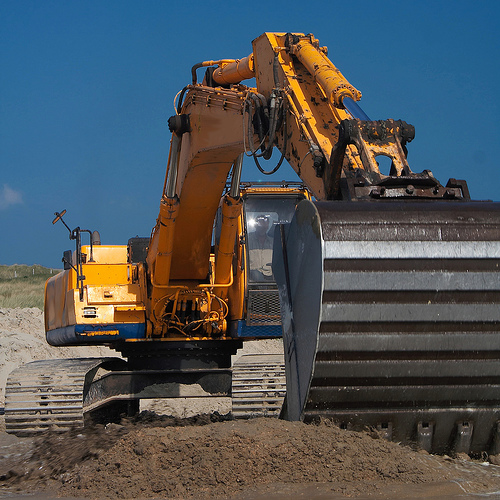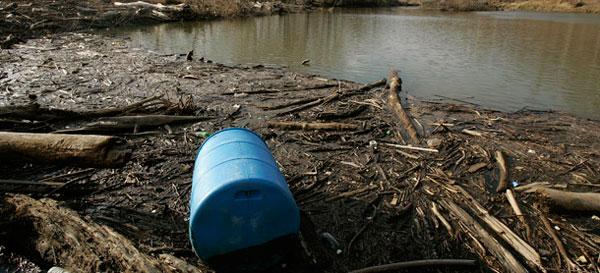sprawl
-
Wal-Mart’s history of destroying sacred sites
A re-consecration ceremony was held this past weekend at a damaged Indian mound in Oxford, Ala. As we reported last month, the 1,500-year-old sacred and archaeologically significant site was partially demolished during a taxpayer-funded economic development project, with the excavated dirt to be used as fill for construction of a Sam’s Club, a retail warehouse […]
-
Alabama city backing away from destruction of ancient Indian mound?
Following local protests and international outcry, the city of Oxford, Ala. appears to be backing away from plans to destroy an ancient and archaeologically significant Indian mound in order to use the dirt as fill for a new Sam’s Club, a retail warehouse store operated by Wal-Mart. A local landowner says his property will now […]
-
Competition dreams up new ways to harass suburbanites
Dwell magazine and Inhabitat have teamed up to sponsor a “Reburbia” competition in which designers re-envision suburbia in ways that make environmentalists seem as scary and dingbatty as possible. The finalists include a lot of inspiring ideas, but my favorite by far is the proposal to have menacing 3,000-foot-tall robots stomp into suburban villages, rip […]
-
Alabama city destroying ancient Indian mound for Sam’s Club
City leaders in Oxford, Ala. have approved the destruction of a 1,500-year-old Native American ceremonial mound and are using the dirt as fill for a new Sam’s Club, a retail warehouse store operated by Wal-Mart. A University of Alabama archaeology report commissioned by the city found that the site was historically significant as the largest […]
-
Help for the hurting Potomac
A plastic 55-gallon barrell is seen amongst piles of driftwood and mud along the Potomac River in Cropley, MD. The main culprits for the river’s deteriorating health are agricultural runoff and suburban sprawl due to a booming local population. This CAP post looks at some useful responses. Global warming is on the national and […]
-
Transportation policy and the working married woman
Progressives in favor of congestion pricing on highways and in central cities tend to argue for those policies on progressive grounds (shock!) -- that such pricing systems reduce emissions, improve air quality, and fund transit improvements, which benefit lower- and middle-income households. Those are all nice benefits to congestion pricing programs, but we shouldn't neglect the congestion reduction function.
Congestion costs America some $80 billion per year, in the form of lost time and wasted fuel. And as it turns out, commutes extended by congestion have other effects, as well:
There is a strong empirical evidence demonstrating that labor force participation rates of married women are negatively correlated with commuting time. What is more, the analysis shows that metropolitan areas which experienced relatively large increases in average commuting time between 1980 and 2000 also had slower growth of labor force participation of married women.
Long commutes are typically associated with dense cities like New York, but in recent decades, congestion has grown fastest in places with rapid exurban growth -- like Dallas, Riverside (California), San Diego, and Washington, D.C.
-
Images of an evolving world by artist Don Simon
These images are from a series of drawings titled “Unnaturalism” by artist Don Simon. His work examines the impact of industrialization and sprawl on ecosystems. From his artist statement: “Throughout history, particularly since the beginning of the Industrial Revolution, mankind has been less than kind to our cohabitants on the planet. We build, produce, and […]
-
Phoenix: What happens when a city built on growth begins to shrink?
During a session called "Sustainability and Growth: How Can a City Develop Sustainably When its Identity is Built on Growth?" at the American Meteorological Society convention, a development expert named Grady Grammage colorfully dispelled some myths and revealed some little-known truths about Phoenix.
One myth: Phoenix is unsustainable because it imports water. Virtually all cities import water, Grammage pointed out, even New York, not to mention countless other necessities for urban life, such as food, fuel, and steel. Phoenix arguably has a more stable supply of water than numerous other cities, such as San Diego, because Phoenix imports its water from numerous sources, albeit at great distances.
In Grammage's view, a bigger question is "habitability," and he brought up the Urban Heat Island Effect, which he thinks, based on surveys, will drive more Phoenicians out of the state by 2020 than those who move in from other states. Grammage reports that when he expressed this view, various public officials and "water buffaloes" -- water experts -- in Phoenix scoffed.They think Phoenix could support as many as 10 million people -- more than twice its current population.
-
Massive flooding in western Washington linked to man-made causes
After digging itself out of "Snowmageddon" over the holidays, western Washington was hit with heavy rainfall this week, causing massive flooding. Roads, including major arteries like I-5 (pictured above), are closed and entire neighborhoods evacuated.
Sure, Seattle's known for its rain, but this is ridiculous! So who's responsible? Well, us, it turns out.
Scientists say a man-made triple whammy of logging, development, and climate change are to blame. And we shouldn't be surprised ...
A year ago (almost to the day), University of Washington geologist David Montgomery issued a warning to state legislators about the flooding that ravaged the region in 2007:



